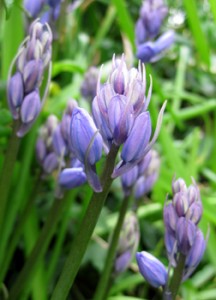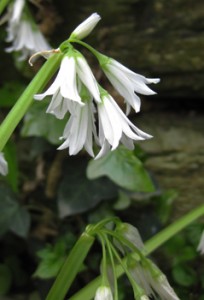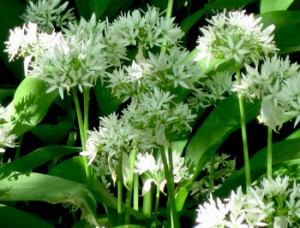 The swallows are back. Chiffchaffs and Blackcaps too have returned and are singing in hedgerows. It must be spring at last. What a contrast to March, when such joyful returns were more resonably expected. The weather was cold, wet and often blowing gales from the North and East. No snow drifts here. However, in the marine environment there has been dramatic accretion of sand and sediment on some beaches, apparently stolen from others now showing bare rock. At Towan, amongst the beach debris of seaweed and the plastic evidence of human existence, there appeared a wealth of beautiful shells, signalling the havoc wreaked by the ocean surge on marine life. Some bivalve molluscs were evidently still alive in their shells, despite being high up along the tideline.
The swallows are back. Chiffchaffs and Blackcaps too have returned and are singing in hedgerows. It must be spring at last. What a contrast to March, when such joyful returns were more resonably expected. The weather was cold, wet and often blowing gales from the North and East. No snow drifts here. However, in the marine environment there has been dramatic accretion of sand and sediment on some beaches, apparently stolen from others now showing bare rock. At Towan, amongst the beach debris of seaweed and the plastic evidence of human existence, there appeared a wealth of beautiful shells, signalling the havoc wreaked by the ocean surge on marine life. Some bivalve molluscs were evidently still alive in their shells, despite being high up along the tideline.
Now the weather is warmer, nature is positively rushing to get productive. The first tortoiseshell and peacock butterflies emerged around the beginning of April. I’ve already seen blackbird nestlings well on their way to fledging, whilst other bird species are busy with nest construction. Their energy demands are as great as ever, so they visit bird tables and feeders continually. My neighbourhood gulls likewise are mating noisily and begging for more handouts. In the hedgerows plants are responding rapidly to the warmer temperatures and we can soon expect a colourful froth of cow parsley (Anthriscus sylvestris), campion (Silene dioica) and alexanders (Smyrnium olusatrum) to enter the competition for space.


One iconic plant of spring, the Bluebell (Hyacinthoides non-scripta), is pushing its way skyward. Here in the Roseland, as in many other parts of the UK, you will see two different species: the English Bluebell and the horticultural hybrid (Hyacinthoides x Massartiana), commonly called Spanish bluebell. Telling the difference between the two species is not difficult. English bluebells have narrowly bell-shaped flowers, with straight, strong blue petals and creamy white anthers, and are held in a sideways fashion on the stem. Spanish bluebells have paler flowers that splay out at the bottom, and are held around an upright stem. The anthers are pale to dark blue. One further difference is the scent. While Spanish bluebells have little or no scent, the English bluebell has heady, hyacinth-like scent. A woodland of English bluebells in full bloom is fragrant with it. However, this phenomenon is threatened due to hybridisation with the horticultural plants. According to an ongoing survey run by the Natural History Museum, most of the plants seen in and around human habitation now consist of these hybrids. The Royal Horticultural Society now advises against growing them in rural gardens, owing to their ability to spread rapidly as weeds and thus to contaminate the genetic purity of wild English bluebells.
Another type of spring flowering bulbous perennial that is often confused with a similar species is the three-cornered leek (Allium triquetrum), commonly misnamed wild garlic. Three-cornered leeks are now well in flower, and the true wild garlic (Allium ursinum) is not far off doing the same. There are a number of features that clearly distinguish them.

Three-cornered leek is so-called because the stem, in cross-section, is a triangle with concave sides. The white flowers produced at the top of the stem are pendant, and have a green centre line down each tepal; the leaves are elongated and strap-like. The flowering plants are seen along our hedgerows and pathways and give out a distinctive onion smell. The species is native to Southern Europe and North Africa, having been introduced to Britain and other parts of the world. It has a tendency to spread invasively, and is included on the RHS list of garden thugs as a potential pest. Best kept in a pot in gardens if you like it, it is, nonethelss, somewhat attractive growing in wild drifts; although the smell can be overpowering in warm weather. All parts of the plant, from the bulb to the flowers, are edible, so dig up and consume invasive patches with abandon if you enjoy the current trend for foraging for wild foods.
 Wild garlic, by contrast, is a British native (yeay!). Commonly known as ramson, it is also a bulbous perennial. It prefers deciduous woodland, and is often seen with bluebells. The leaves of the plant are elliptical, very similar to Lily of the Valley (Convallaria majalis). The all white, starry flowers, unlike three-cornered leek, are held upright in umbels above the stem. The stem itself is also three-sided but is almost circular in cross-section. Species colonies spread rapidly in favourable habitat, similar to their leek cousins, so a garden stock should also be strictly contained. All parts of wild garlic are edible, but it is the leaves, rather than the tiny bulbs, that are preferred in culinary use – as an accompaniment to cheese, for example. Cornish Garlic Yarg cheese is wrapped in the leaves during the maturation process, giving it its distinctive flavour. You can find lots of interesting recipes online that use wild garlic, as well as three-cornered leek. Try this one here, for example.
Wild garlic, by contrast, is a British native (yeay!). Commonly known as ramson, it is also a bulbous perennial. It prefers deciduous woodland, and is often seen with bluebells. The leaves of the plant are elliptical, very similar to Lily of the Valley (Convallaria majalis). The all white, starry flowers, unlike three-cornered leek, are held upright in umbels above the stem. The stem itself is also three-sided but is almost circular in cross-section. Species colonies spread rapidly in favourable habitat, similar to their leek cousins, so a garden stock should also be strictly contained. All parts of wild garlic are edible, but it is the leaves, rather than the tiny bulbs, that are preferred in culinary use – as an accompaniment to cheese, for example. Cornish Garlic Yarg cheese is wrapped in the leaves during the maturation process, giving it its distinctive flavour. You can find lots of interesting recipes online that use wild garlic, as well as three-cornered leek. Try this one here, for example.
Latest news from the RSPB’s Cirl bunting reintroduction project
 Monitoring of our local population of Cirl buntings is now focussing on reproductive activity. Last year the wet summer had a big impact on productivity, despite the increased number of pairings on the previous year. Stuart and I have so far managed to log some 20 pairs of birds this season. We do not expect to reach last year’s total of 44 pairs but things are progressing well at the start of the season. At least 60{c8c3b3d140ed11cb7662417ff7b2dc686ffa9c2daf0848ac14f76e68f36d0c20} of the birds are now wild bred and unringed, presenting us with a greater challenge in identifying the paired and unpaired individuals. But just like your thumb print, Cirls have unique plumage markings that can help us in our task. Let’s hope the weather this year is a lot better for them and us and I can report improved productivity later in the year.
Monitoring of our local population of Cirl buntings is now focussing on reproductive activity. Last year the wet summer had a big impact on productivity, despite the increased number of pairings on the previous year. Stuart and I have so far managed to log some 20 pairs of birds this season. We do not expect to reach last year’s total of 44 pairs but things are progressing well at the start of the season. At least 60{c8c3b3d140ed11cb7662417ff7b2dc686ffa9c2daf0848ac14f76e68f36d0c20} of the birds are now wild bred and unringed, presenting us with a greater challenge in identifying the paired and unpaired individuals. But just like your thumb print, Cirls have unique plumage markings that can help us in our task. Let’s hope the weather this year is a lot better for them and us and I can report improved productivity later in the year.
Did you know…?
Concerned by the presence of a Sparrowhawk in your area? Well take heart, predation is not always a benefit to the predator alone and Nature is never wasteful. According to the British Trust for Ornithology recently, Long-tailed Tits are one of many species to home in on the remainder of Sparrowhawk kills. The nests they build are made up of thousands of downy feathers stripped from the corpse, as well as pieces of lichen and spider silk binding it all together into a thing of practical beauty.
References:
Bluebells as weeds
http://apps.rhs.org.uk/advicesearch/profile.aspx?pid=426
Natural History Museum Bluebell Survey
Natural History Museum Bluebell Survey latest
Wild garlic recipes
http://www.deliciousmagazine.co.uk/articles/call-of-the-wild-garlic
RHS Wild and Crow Garlic
http://apps.rhs.org.uk/advicesearch/profile.aspx?pid=384
Enjoy more Roseland wildlife and landscapes – visit my Heart of Roseland Facebook page:
https://www.facebook.com/HeartOfRoseland?ref=hl
Sarah Vandome works for the RSPB and is a conservation scientist and fellow member of the British Trust for Ornithology.
All Photography © by Sarah E Vandome.

